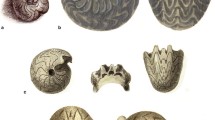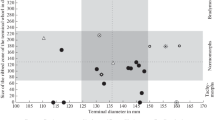Summary
Bifericeras bifer shows two common anomalies. Old apertures appear in the 4th whorl, and in the 3rd one a trochospiral growth can start. Starting with this observations, the growth ofBifericeras bifer andLeptonotoceras sp. is discussed. Both ammonites show the same stratigraphical distribution, andLeptonotoceras sp. has the same skulpture asBifericeras on its inner whorls. The study of growth showed that there is no difference in the developement of the parameters except the whorl width. Both ammonites show several identical interruptions in growth. There is the well known one at the end of the first whorl, and another one follows at the end of the 2nd whorl. This second interruption is explained as reaction on the preceding one. Both ammonites show a change in the growth of whorl width in the third whorl. Here the trochospiral growth can be determined. At the end of the 4th whorl the growth ofLeptonotoceras stops, whileBifericeras shows a change of growth in nearly all parameters and in sculpture. Here also the old apertures appear. The analysis of the coiling spiral and the developement of the distance of septae allows to calculate the length of body chamber during the ontogeny. This shows that the first septum was secreted at the end of the first whorl. Then the bodychamber has a constant length of 180°. A shortening was recognized at the end of the 2nd whorl. It can be explained by an expansion of the whorl section, which is caused in the interruption of the first whorl. The identical mode of growth, the sculpture, and the anomalies show thatBifericeras bifer andLeptonotoceras sp. sensuSöll belong to the same genus. Probably the slight differencies may be interpretated as sexual dimorphism.
Zusammenfassung
Bifericeras zeigt häufig Anomalien. In der 4. Windung treten alte Mundsäume auf und in der 3. Windung kann ein trochospirales Wachstum einsetzen. Das Wachstum vonBifericeras bifer wurde daher näher untersucht und mit dem vonLeptonotoceras sp. sensuSöll verglichen. Beide Ammoniten zeigen dieselbe stratigraphische Reichweite. Die Skulptur vonLeptonotoceras entspricht der der Innenwindungen vonBifericeras, und die Entwicklung der Gehäuseseparameter ist bei beiden Ammoniten identisch. Unterschiede treten hier nur in der Entwicklung der Windungsbreite auf, die in der dritten Windung einsetzen. Der Entwicklungstrend verläuft jedoch auch hier gleichartig. Die sehr weitgehende Übereinstimmung im Wachstum läßt eine Stellung der beiden Ammoniten in verschiedene Gattungen hicht zu. Eventuell könnte hier unter Berücksichtigung der Anomalien ein Sexualdimorphismus diskutiert werden.
Similar content being viewed by others
Literatur
Bacci, G.: Sex Determination. — Intern. Ser. Monogr., Pure a. Appl. Biol., Div. Zool.,26, London 1965.
Bayer, U.: Anomalien bei Ammoniten des Aaleniums und Bajociums und ihre Beziehung zur Lebensweise. — N. Jb. Geol. Paläont. Abh.,135, 1, 19–41, Stuttgart 1970.
—: Zur Ontogenie und Variabilität des jurassischen Ammoniten Leioceras opalinum. — N. Jb. Geol. Paläont. Abh.,140, 3, 306–327, Stuttgart 1972.
Callomon, J. H.: Sexual Dimorphism in Jurassic Ammonites. — Transact. Leic. Lit. Phil. Soc.,LVII, Leicester 1963.
Callomon, J. H.: Dimorphism in Jurassic Ammonites. — In: Sexual Dimorphism in Fossil Metazoa and Taxonomic Implications. Int. Un. Geol. Sc.,A, 1, Stuttgart 1969.
Dean, W. T., D. T. Donovan &M. K. Howarth: The Liassic Ammonite Zones and Subzones of the North-West European Province. — Bull. Brit. Mus. (Nat. Hist.), Geology,4, 10, London 1961.
Eichler, R. &H. Ristedt: Untersuchungen zur Frühontogenie von Nautilus pompilius (Linne). — Paläont. Z.,40, 3/4 173–191, Stuttgart 1966.
Erben, H. K., G. Flajs &A. Stehl: Die frühontogenetische Entwicklung der Schalenstruktur ectocochliater Cephalopoden. — Palaeontographica, A,132, 1–54, Stuttgart 1969.
Fraas, O.: Abnormitäten bei Ammoniten. — Jh. Ver. vaterl. Naturkde. Württemberg,19, 111–113, Stuttgart 1863.
Haarländer, W.: Die Spirale der Ammonoiden. — Geol. Bl. NO-Bayern,2, 1, 1952.
Hoffmann, K.: Die Ammoniten des Lias beta der Langenbrückener Senke I. — Beitr. naturk. Forsch. SW-Deutschl.1, 2, Karlsruhe 1936.
—: Die Ammoniten des Lias beta der Langenbrückener Senke II. — Beitr. naturkd. Forsch. SW-Deutschl.3, 1, Karlsruhe 1938.
Hölder, H.: Über Anomalien an jurassischen Ammoniten. — Paläont. Z.,30, 1/2, 95 bis 107, Stuttgart 1956.
—: Zur Frage des Wachstumsendes bei Ammoniten. — Paläont. Z.,34, 1/2, 61–68, Stuttgart 1960.
Huxley, J. S.: Problems of Relative Growth. — New York (Dial Press) 1932.
Kullmann, J. &J. Scheuch: Wachstums-Änderungen in der Ontogenese paläozoischer Ammonoideen. — Lethaia,3, 397–412, Oslo 1970.
—: Absolutes und relatives Wachstum bei Ammonoideen. — Lethaia5, 129–146, Oslo 1972.
Lehmann, U.: Dimorphismus bei Ammoniten der Ahrensburger Lias-Geschiebe. — Paläont. Z.,40, 1/2, 26–55, 1966.
—: Dimorphismus und Apophysenausbildung bei Grammoceras doerntense (Denckmann) (Ammonoidea, Oberes Toarcium). — Paläont. Z.,43, 3/4, 169–176, Stuttgart 1969.
Makowski, H.: Problem of sexual dimorphism in ammonites. — Palaeont. Polonica,12, 1–92, 1963.
Moore, R. C. (ed.): Treatise on Invertebrate Palaeontology, Part L, Mollusca 4. — Kansas 1957.
Palframan, D. F. B.: Variation and ontogeny of some Oxfordian ammonites: Taramelliceras richei (deLoriol) and Creniceras rengeri (Oppel), from Woodham, Buckinghamshire. — Palaeontology,9, 290–311, 1966.
—: Variation and ontogeny of some Oxford Clay ammonites: Distichoceras bicostatum (Stahl) and Horioceras baugieri d'Orbigny), from England. — Palaeontology,10, 60–94, London 1967.
Schindewolf, O. H.: Studien zur Stammesgeschichte der Ammoniten. Lfg. I–IV. — Abh. Akad. Wiss. u. Lit., math.-naturw. Kl., Mainz, 1960–65.
Söll, H.: Stratigraphie und Ammonitenfauna des mittleren und oberen Lias β (Lotharingien) in Mittel-Württemberg. — Geol. Jb.,72, 367–434, Hannover 1956.
Siahl, W. &Jordan, R.: General Considerations on Isotopic Palaeotemperature Determinations and Analyses on Jurassic Ammonites. — Earth a. Plan. Sc. Lett.,6 (1969), 173–178, Amsterdam 1969.
Thompson, D'A. W.: On Growth and Form. — 2 Bde., 2. Aufl., Cambridge (Univ. Press) 1952.
Westermann, G. E. G.: Form, Structure and Function of Shell and Siphuncle in coiled Mesozoic Ammonoids. — Life Sc. Contr. Royal. Ont. Mus.,78, 1971.
Author information
Authors and Affiliations
Additional information
Mit Tafel 29 und 7 Textabbildungen
Rights and permissions
About this article
Cite this article
Bayer, U. Ontogenie der liassischen AmmonitengattungBifericeras . Paläont. Z. 46, 225–241 (1972). https://doi.org/10.1007/BF02990155
Published:
Issue Date:
DOI: https://doi.org/10.1007/BF02990155




